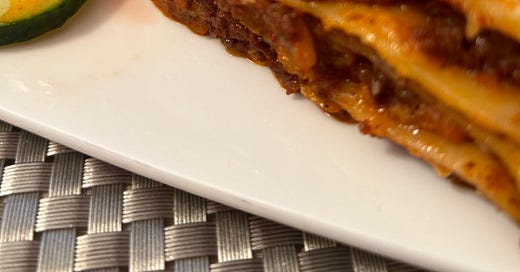Lasagna Bolognese
Lasagna is a very satisfying dish to serve when entertaining friends or gathering with family. I make this multistep recipe easier by using oven-ready, no-boil noodles.
This lasagna may be a little different from what you’re used to. For one thing, there is no ricotta or mozzarella cheese. This recipe is adapted from the Italian Bible of cooking, the Silver Spoon Cookbook—chances are, if you visited someone in Italy and they made you lasagna, it would be a lot like this, though not necessarily gluten free (although I’ll note that Italy is a pretty GF-friendly place to travel).
This recipe is a little longer than some of the others I’ve written up, because it involves making two sauces, then assembling and baking—and I’m going to describe each of the sauces and the assembly separately.
With all that effort, you’ll probably want to make this when entertaining friends or gathering with family, so the portions I describe are going to look huge. This will make a decent-sized lasagna that should feed up to eight people. If you want to make a smaller version, just halve all the ingredients, and you’ll still have enough to provide a single person with more than one meal (it reheats nicely).
The first question that probably popped into your mind was, “What gluten free lasagna noodles do you use?” Well, I’ve used two brands: the first (Tinkyada) requires boiling the pasta before using it, and the second (Barilla) is a no-boil version. For more about the different types of noodles and how to use them (it affects the lasagna assembly), scroll down to note 7, where I go into a lot more detail. In this version of the recipe, I’m going to use the oven-ready, no-boil noodles.
And the other question, returning to the difference I mentioned earlier, is, “Why no ricotta or mozzarella?” Well, this lasagna Bolognese layers in bechamel sauce, butter, and Parmesan cheese, which make it very rich, so you’re not going to miss the other cheeses.
The equipment you’ll need for this include a wire whisk, a large sauté pan, a 2-quart sauce pan, and a 3-quart baking dish (I used a 9 x 13-inch Pyrex pan), and note that you’ll preheat the oven to 400 degrees F (375 convection).
And with that, the first thing you need to do is make the meat sauce….
Meat sauce ingredients:
6 tablespoons olive oil
1 ½ cups diced carrot (see note 1)
1 ½ cups diced yellow onion
2 pounds ground beef (see note 2)
1 cup red or white wine
2 cups tomato puree
Salt and pepper
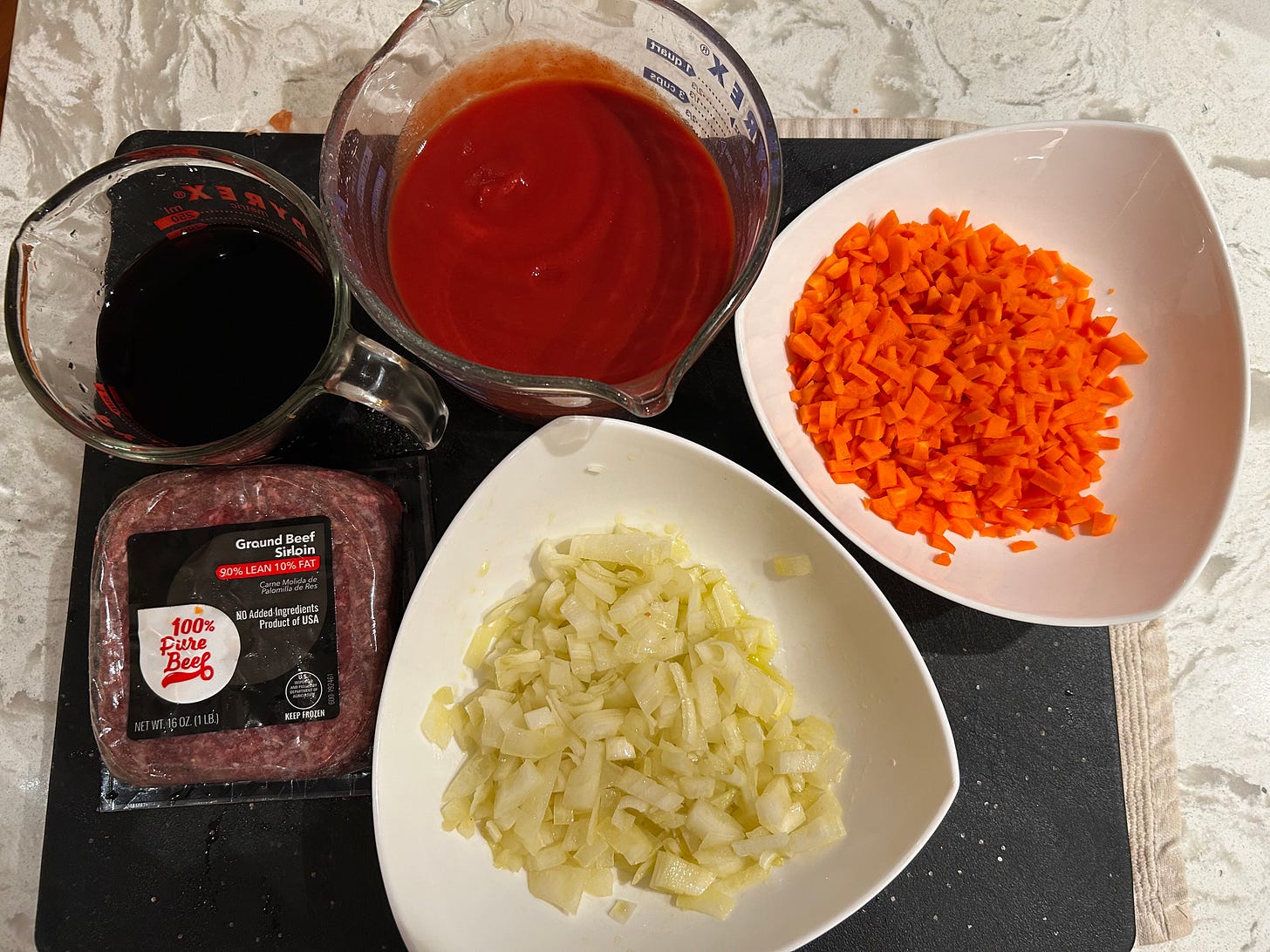
Meat sauce directions:
Using a large sauté pan over medium-high heat, cook the diced carrot and onion in the olive oil until they start to soften, but not brown (about 5 to 10 minutes), then remove them from the pan
Brown the beef in the sauté pan over high heat, using a spatula to break it up into small pieces (see note 3)
Add the wine, tomato puree, and sauteed vegetables to the pan
Season the sauce with salt and pepper, turn the heat to low, and simmer about 30 minutes to thicken
Bechamel sauce ingredients:
½ cup butter (1 stick)
½ cup gluten-free, all-purpose flour (I recommend King Arthur brand, see note 4)
4 ½ cups warm milk (see note 5)
Bechamel sauce directions:
Melt the butter over medium heat in a 2-quart sauce pan
Whisk the flour into the melted butter until smooth
Using a ladle, add about 1 cup of warm milk and whisk until the liquid is absorbed by the flour mixture
Ladle by ladle, add the remaining milk, whisking to incorporate the liquid with the flour after each addition
When all the milk has been added and whisked until the sauce is smooth, continue to heat the sauce, stirring occasionally, until thickened (see note 6)
Lasagna assembly ingredients:
The meat sauce
The bechamel sauce
About 2 tablespoons cold butter, cut into cubes
2 cups grated Parmesan cheese
1 box Barilla gluten-free, oven-ready lasagna noodles (see note 7 for the boiled noodle version and how prep and assembly differ)
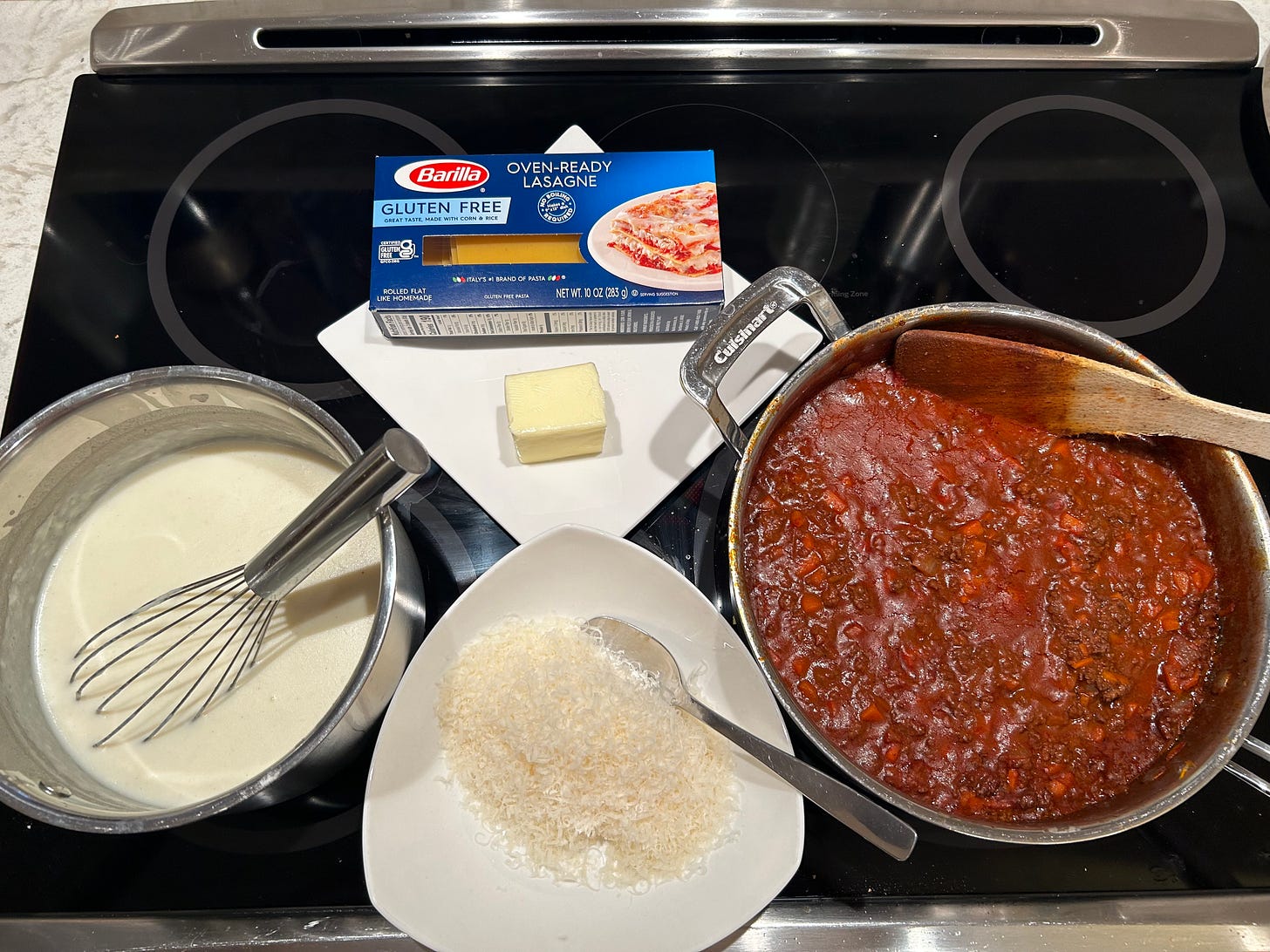
Lasagna assembly directions:
Preheat the oven to 400 degrees F, or 375 if using convection
Start with the meat sauce: Add a thin layer of sauce to the bottom of the pan
Next the bechamel: Drizzle bechamel over the meat sauce (see photo below and note 8)
Next the butter and cheese: Dot about six small cubes of butter across the first layer, then sprinkle a few spoonfuls of grated cheese
Finally, the noodles: Place the noodles side-by-side over the sauce layer (see note 9)
Continue layering sauces, butter, cheese, and noodles in the same pattern to use all of the meat sauce, butter, and cheese, and all but about 2 cups of bechamel (see note 10)
On top of the final layer of sauces, butter, and cheese, add a final layer of noodles and use the remaining 2 cups of bechamel to completely cover the noodles (see note 11)
Place in the oven and bake for 30 minutes (longer if you want the top extra brown)
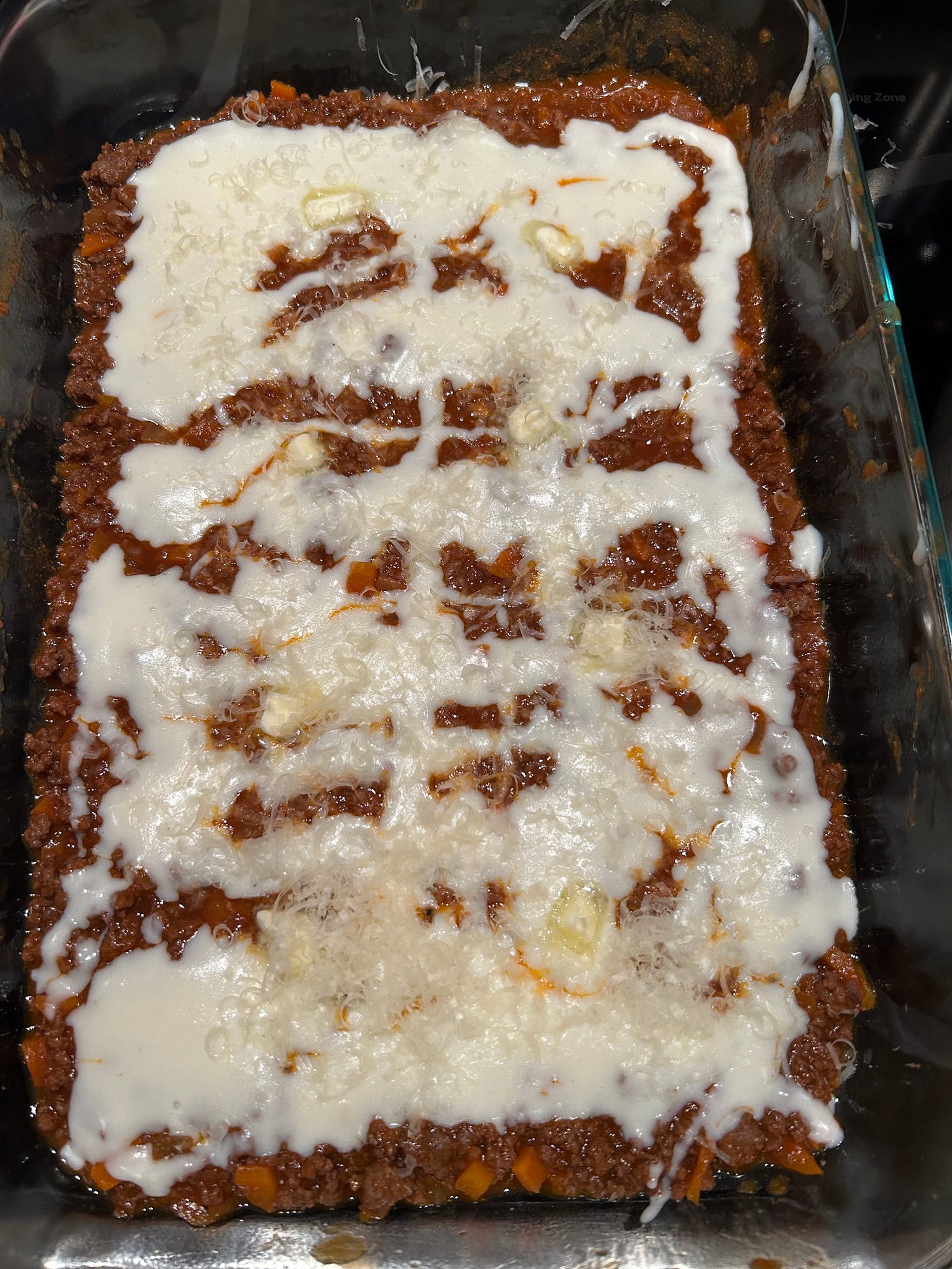
Notes:
Rather than tell you “1 large onion” or “2 medium carrots”, I say how much of each vegetable you should have once they’re diced. But if you select 1 large onion (or 2 medium-smallish onions!) and 2 medium carrots (or 1 large carrot!), they should get you to that amount.
For this kind of dish, I use ground beef with a lower fat content, such as 90% lean/10% fat. The dish has enough fat from the dairy products, so having higher fat content in the beef could make the lasagna seem greasy.
Some recipes will tell you to add the beef to the vegetable mixture, but I’ve found that the beef will brown more quickly if you remove the vegetables. I use a flat wooden spatula to break up the ground beef as it browns. You’ll want the beef to be broken up into very small bits like gravel, not big chunks like marbles.
If you’ve read my other recipes, you know I like to use King Arthur gluten-free, all-purpose flour for thickening sauces. If you choose a different blended flour, make sure it includes xanthan gum—if it doesn’t, add about a ¼ teaspoon of xanthan gum. Most single-ingredient flours, such as rice flour, will not work for this, as the grind is too course to absorb the liquid, so it will just settle to the bottom of the pan. Also, this is the same béchamel sauce recipe that I used in my recipe for macaroni and cheese, but with the ingredients doubled.
Heat the milk just until it’s warm to the touch—don’t boil or scald it. I use a sauce pan over low heat to do this, but you can do it in the microwave if you prefer.
The bechamel will not seem very thick at first, but it will thicken with time. After about 5 minutes over low heat (stirring will keep lumps from forming at the bottom), it should be thick enough to use.
Here is my important note about boiled versus non-boiled, oven-ready lasagna noodles. First the boiled noodles: If you opt for a boiled version, such as Tinkyada brand, you will need to partially cook the noodles by dropping them in boiling water and being sure to stir them, so they don’t stick together. It should take only about 2–3 minutes to get them soft enough for use. Carefully remove each noodle, one at a time, and lay them side-by-side on a clean dish towel until you’re ready to start assembling. With this type of noodle, you can begin with a layer of noodles on the bottom of the pan. You’ll want to grease the pan first by rubbing butter across the surface. After the layer of noodles, proceed with the layers of sauces and noodles as described above. Note that it is still important to make sure the top layer of noodles is completely covered with bechamel, as that will keep them from drying out in the oven and becoming crunchy. Now the oven-ready, no-boil noodles: Because these noodles cook by using the liquid from the sauce that surrounds them during baking, it is important to begin by putting a layer of sauce on the bottom of the pan and finish by completely covering the top layer of noodles with bechamel sauce.
The meat layers just need a bit of bechamel sauce and don’t need to be completely covered, as in the photo. You want to be sure to have enough bechamel left (about 2 cups) to cover the final layer of noodles so they cook while baking.
It is ok if the noodles overlap a little bit, by a quarter inch or so. For the top layer of noodles, which will be covered by the final layer of bechamel, I tend to use fewer noodles, spacing them farther apart to be sure they cook thoroughly.
The number of layers and noodles you use will likely depend on the shape and depth of your baking dish. In my 9 x 13 dish, I had 3 sauce layers and 3 noodle layers, and I used 16 noodles total (there are 16 in a box, so I used 6 on each of the first two layers and 4 on the final layer that gets covered with bechamel).
As I’ve described in the notes above, it’s really important to have enough bechamel sauce to completely cover the top layer of noodles. The oven-ready noodles will not cook if they don’t have enough liquid to absorb, and even the boiled noodles will dry out and get crunchy if they are not covered. I used about 2 full cups of bechamel to finish the top layer, but if you have more than 2 cups, just use it all.
Cat update:
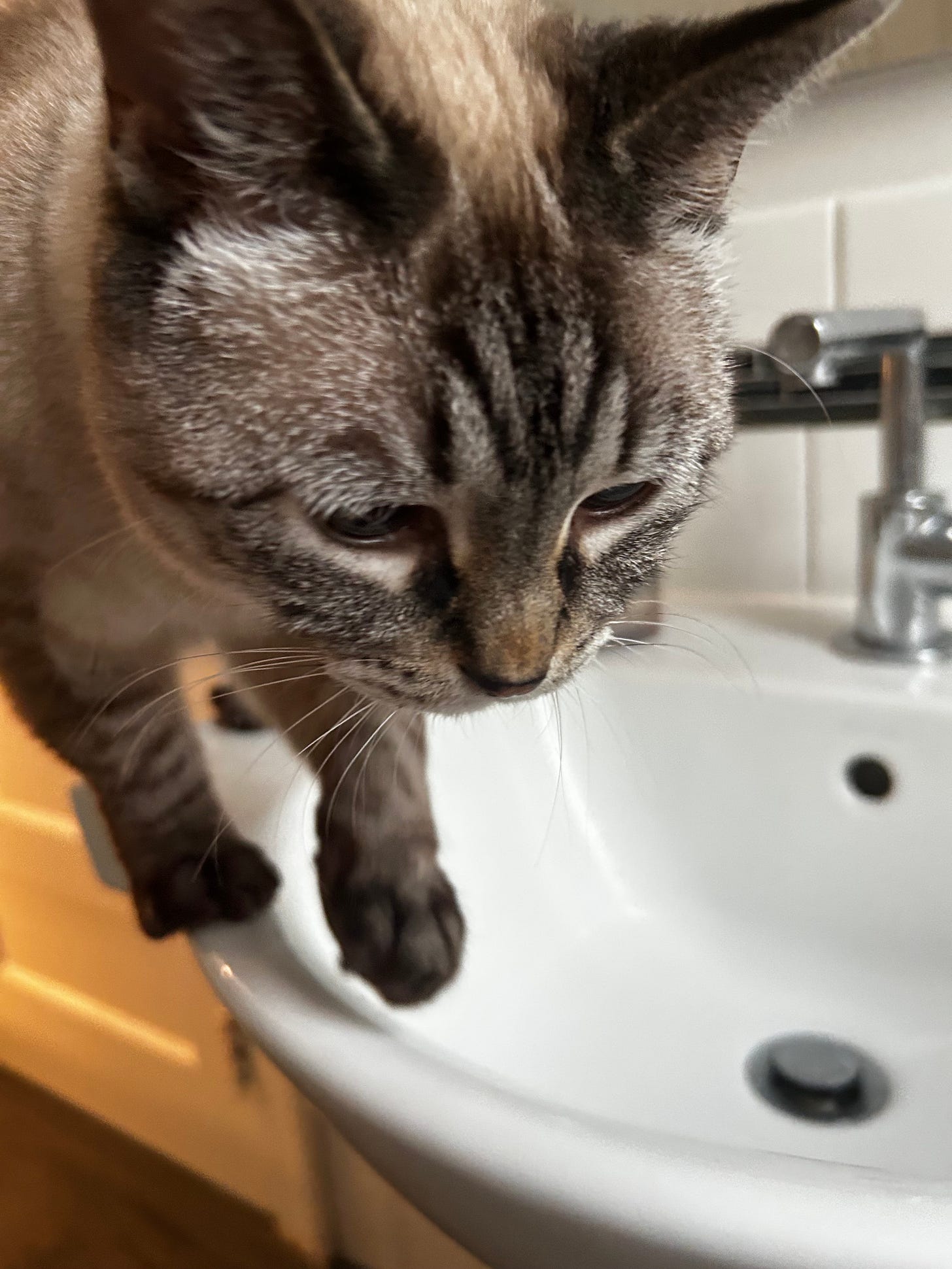
Many cat owners are familiar with having their cats follow them into the bathroom. With Seraphina, if the bathroom door is closed, she will sit outside, waiting. If it is open, she will join me inside. If it is getting close to mealtime, she’ll make sure I notice her by jumping onto the window sill and knocking whatever she finds there onto the floor (a razor, for example). And she might even jump into the sink to be extra sure I notice her, as in this photo.

